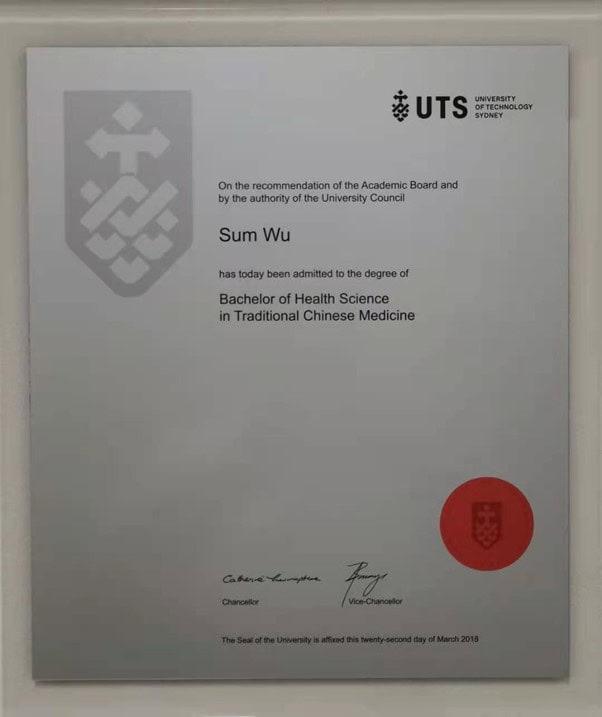 2025年09月09日 14:37 发布
编辑:Editor
2025年09月09日 14:37 发布
编辑:Editor
Sum Wu
Registered Chinese Medicine Practitioner
Bachelor of Health Science in Traditional Chinese Medicine (UTS)
Bachelor of Science Majoring in Psychology (UOW)
Director of Hurstville Chinese Herbs Centre
Vice Dean of College of Traditional Chinese Medicine Orthopedics Australia
Specialising in pain management and mental wellbeing through Tradition Chinese medicine in combination with modern science in mental health, dieting and nutrition.
吴宇琛,澳大利亚政府注册中医师、针灸师,五龙岗大学心理学学士、悉尼科技大学中医系学士,澳大利亚松轩中医药中心主任医师,澳大利亚中医骨伤专科学院副院长。
擅长用传统针灸理伤手法和中药治疗各种新旧损伤痛症,特别采用中医中药和现代心理学、营养学相结合调理治疗各种慢性病和亚健康。

In recent years, both Traditional Chinese Medicine (TCM) practices and contemporary manual therapy methods have gained popularity for their effectiveness in treating musculoskeletal pain, improving circulation, and enhancing recovery. Among these approaches, Gua Sha and the Graston Technique are two methods that share similarities yet arise from very different cultural and clinical origins.
近年来,中医传统疗法与现代手法治疗因其在治疗肌肉骨骼疼痛、改善循环和促进康复方面的疗效而逐渐受到欢迎。在这些方法中,刮痧与Graston技术既有相似之处,又源自截然不同的文化与临床背景。
Origins and Philosophies起源与理念
Gua Sha is a traditional healing method that has been practiced in China and other parts of Asia for centuries. The name translates to “scraping sand,” referencing the reddish or purplish marks that often appear on the skin after treatment. Rooted in TCM principles, Gua Sha is based on the belief that stagnation of Qi and blood can cause pain or illness. By scraping the skin with a smooth-edged tool, practitioners aim to restore circulation, release heat, and stimulate the body’s self-healing mechanisms.
刮痧是一种传统的治疗方法,在中国及其他亚洲地区已有数百年的应用历史。其名称意为“刮痧”,指的是治疗后皮肤上常见的红色或紫色痕迹。刮痧植根于中医理论,认为气血瘀滞会导致疼痛或疾病。通过使用光滑边缘的工具刮拭皮肤,施术者旨在促进气血流通,清解郁热,并激发人体的自愈能力。
The Graston Technique, on the other hand, was developed in the United States in the 1990s as a specialized form of instrument-assisted soft tissue mobilisation (IASTM). Grounded in Western biomedical science, it focuses on breaking down scar tissue and fascial restrictions that can develop after injury, surgery, or chronic overuse. Graston is highly systematised, taught through certification programs, and supported by clinical research in sports medicine and rehabilitation.
Graston技术则于20世纪90年代在美国发展起来,是一种专门的器械辅助软组织松动术(IASTM)。它基于西方生物医学,主要针对因损伤、手术或长期过度使用而形成的瘢痕组织与筋膜粘连。与刮痧不同,Graston技术体系化程度很高,通过认证课程进行培训,并在运动医学和康复领域有临床研究支持。
Tools and Methods工具与方法
Both methods use tools to apply friction to the skin, but their instruments differ in appearance and materials.
两种方法都借助工具在皮肤上产生摩擦,但其器具的材质与外形有所不同。
Gua Sha tools are traditionally made from jade, horn, porcelain, or metal. They often have smooth, curved edges to glide comfortably across the skin after oil is applied. The technique usually involves repeated unidirectional strokes over muscles or meridian pathways.
刮痧工具传统上使用玉石、牛角、瓷器或金属制成,常带有光滑弧形边缘,在涂抹油脂后能顺畅地滑动。手法通常是沿着肌肉或经络反复进行单向刮拭。
Graston instruments are stainless steel with bevelled edges, designed with different shapes to target specific anatomical regions. Practitioners use varied strokes and pressures depending on the tissue being treated, often within the context of a broader rehabilitation program including stretching and strengthening.
Graston器械则由不锈钢制成,边缘呈斜角,有多种不同形状,以便针对不同解剖区域。施术者会根据治疗的组织特点选择不同的力度和手法,并常结合拉伸与强化训练等康复方案一同使用。
Effects and Benefits作用与益处
Despite different origins, Gua Sha and Graston share a key therapeutic goal: mobilizing soft tissue to improve function and reduce pain.
尽管起源不同,刮痧与Graston都以促进软组织活动、改善功能和减轻疼痛为共同目标。
Gua Sha benefits often include relief from muscle tension, headaches, and conditions associated with poor circulation or inflammation. Modern studies suggest that the technique may promote microcirculation and stimulate an anti-inflammatory response. Many patients also report a sense of relaxation and improved range of motion after treatment.
刮痧的好处通常包括缓解肌肉紧张、头痛以及与血液循环不良或炎症相关的问题。现代研究显示,刮痧可促进微循环,并激发抗炎反应。许多患者在治疗后还会感到身心放松,关节活动度有所改善。
Graston Technique benefits are particularly noted in sports medicine and physical therapy. It is frequently used for conditions such as tendinopathies, plantar fasciitis, carpal tunnel syndrome, and post-surgical scarring. Research has shown improvements in tissue mobility, reduced pain, and quicker return to activity in athletes and patients undergoing rehabilitation.
Graston技术在运动医学和物理治疗领域尤为突出。它常用于治疗肌腱病、足底筋膜炎、腕管综合征以及术后疤痕等疾病。研究表明,该技术可改善运动员和康复患者的组织活动能力,减轻疼痛,并加快恢复活动能力。
Key Differences主要区别
While the methods appear similar on the surface, several distinctions are important:
表面上看,两种方法相似,但其差异不容忽视:
Integrative Potential融合与发展
Today, practitioners are increasingly recognising the value of blending traditional and modern approaches. Gua Sha offers a holistic perspective and centuries of clinical experience, while Graston provides evidence-based methods and integration into rehabilitation programs. Patients may benefit from both, depending on their condition, cultural preferences, and treatment goals.
如今,越来越多的临床实践者开始认识到结合传统与现代方法的价值。刮痧提供了整体观念和数百年的临床经验,而Graston则带来循证方法与康复体系的综合。根据病情、文化偏好与治疗目标,患者可能同时受益于两者。
In essence, Gua Sha and the Graston Technique illustrate how different healing traditions can converge on similar ideas: that targeted mechanical stimulation of soft tissue can help restore movement, reduce pain, and enhance the body’s natural healing processes.
总体而言,刮痧与Graston技术展示了不同的治疗传统如何在相似理念上汇聚:通过针对性的软组织机械刺激,帮助恢复运动功能,减轻疼痛,并促进身体的自然康复过程。
如有疑问想咨询吴宇琛中医师,可以在微信或whatsapp搜索61 404836368,加吴宇琛中医师微信或whatsapp,也可以发短信或致电0404836368作语音留言,吴宇琛中医师有空就会回复。
(吴宇琛中医师,澳大利亚政府注册中医师、针灸师,五龙岗大学心理学学士、悉尼科技大学中医系学士,悉尼好思维松轩药行主任中医师,澳大利亚中医骨伤专科学院副院长,本文仅供参考,具体诊疗应咨询专业人士。)
